Historical and architecture monuments
Nikolo-Kremlevskaya Church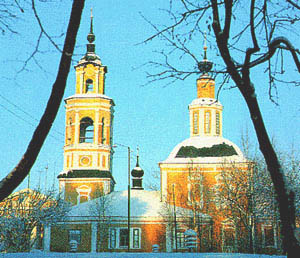
Nikolo-Kremlevskaya Church was built in 1769 when the style of baroque was only penetrating into Vladimir as the church has quite a serene image and a simple decor. There is a belfry attached to the main building of the church. Now Nikolo-Kremlevskaya Church houses the City Planetarium. |
Spaso-Preobrazhensky Church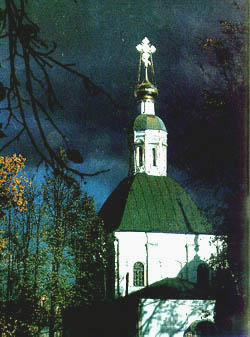
Spaso-Preobrazhensky Church belongs to the end of the XVIIIth century but in history as a great number of other churches it had its predecessor. Here in 1164 was built a palace white stone church of Spas, though this church existed only till the fire of 1778 which brought destruction not only to this church but to many others. This was a temple for trade people. It was erected in the style of old white stone constructions, but nonetheless contained some elements of baroque. Some of the ancient wall paintings inside the church have been preserved. Now it is a parochial functioning church. |
Mikhail Archangel's Church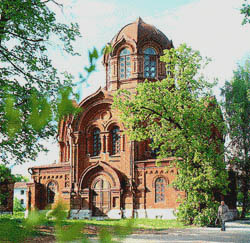
It is located not a long way from the center and the Golden Gate, near the Hotel Zarya. This church is made from red brick and bears all the features of the Byzantine style. Mikhail Archangel's Church was built at the end of the XIXth century. In the past it housed a watch exposition but now is a functioning church. |
The Georgy Church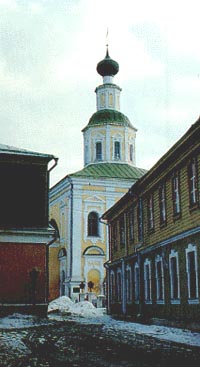
The Georgy Church was founded on old historical places, which once belonged to the prince. The contemporary building of the church was finished in 1796 and is marked by the provincial style of baroque. But it is not the first church in this place as before here stood a white stone church of 1157 erected by Yury Dolgoruky. That church did not survive and was destroyed in the fire of 1778. The only remaining parts of the ancient church are the foundation and lower parts of the walls. Nowadays the Georgy Church houses the Theater of Choral Music. |
The Trinity Church
On Bolshaya Moskovskaya Street in front of the Golden Gates is located the Trinity Church, probably one of the youngest Vladimir churches as it was founded only in the beginning of the XX century (1913-1916). It was built by local Old Believers and is sometimes called the "Red Church" as it is made of red brick. Now the Trinity Church is not a functioning one but instead it was turned into a museum. Its high, bright interior proved to be ideally suited to collections of craft items from the Vladimir region - crystal glass from Gus-Khrustalnyi, needlework and painted lacquer boxes from Mstiora. That is why this building is widely known not as a church but as "Museum of Crystal, Lacquered Miniatures and Embroidery." more... |
The Church of St. Nicolas at the Galleys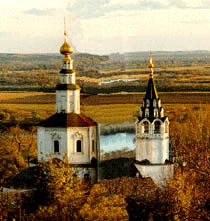
The Church of St. Nicolas at the Galleys is the smallest in Vladimir and nonetheless a very fascinating one, and its building and its history all present a great interest. The Church was built in 1732-1735 and its construction was sponsored by a rich merchant Ivan Grigoriev Pavlygin. The Church of St. Nicolas at the Galleys stands at the foot of the hills where a landing platform on Klyazma used to be, it was this landing platform which gave the church the addition "at the Galleys". Galleys were rowing ships used in the old times and as Vladimir was a trading center, they were in abundance here. Moreover St. Nicolas is a patron saint of seamen, that is why the church is called so and is located so close to the river and the landing platform. The chronicle mentions that already in twelfth century here stood another church also named after St. Nicolas, but it was wooden and was destroyed by time or something more powerful. But the contemporary church is not an exact copy of its predecessor. First of all it is made of stone and is built according to the traditions of its age - XVIIIth century. A broad band of kokoshniki runs across the top of the facades and the nalichniki are particularly ornate. Adjoined to the northwest corner is an original bell-tower, shaped like a square tower with a high spire, the niches of which are set with green tiles. The ancient internal decor and wall paintings are partially preserved and are open to visitors. The Church of St. Nicolas at the Galleys is a functioning church. |
The Princess' Convent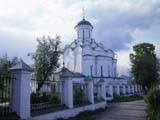
By the 19th century only two monasteries remained out of a great number that once were the decoration and protection of Vladimir. One of them is the Princess" Convent which was founded in 1200 in the North-Western corner of the city by Maria Shavronova, the wife of Prince Vsevolod III. Originally the Convent hosted the Assumption Cathedral, but as it was built of bricks it did not survive the Tartar invasion and was destroyed, like many other buildings in Vladimir. It had been restored only at the turn of 15th-16th century and in the 17th century it was painted by an outstanding 17th century artist - Mark Matveev. His frescoes have been preserved and now are to be seen on the walls of the cathedral. The Princess' monastery was re-instituted in 1992 after being closed in 1923 and the Vladimir-Suzdal Museum-Preserves granted the convent the oldest and the most valuable of its icons, the "God-Loving Mother of God", so you still have a chance of visiting such a marvelous and pacifying place. In order to reach the monastery, it is necessary to turn up from Bolshaya Moscow Street to Devicheskaya Street and then to pass several hundred meters to Lybed. |
The Ensemble of the Nativity Monastery
At the end of the even side of Bolshaya Moskovskaya on the edge of the hill in line with principal and the Prince's cathedrals there used to be one more, the white stone cathedral of the Nativity of the Mother of God, a monastery temple. Founded in 1191 by Vsevolod III, the men's Nativity Monastery occupied a leading position in the hierarchy of Russia's religious houses and was known throughout the country. Only in 1561 it ceded its primacy to the Trinity-Sergiyev monastery and in 1720 also to the Alexander Nevsky Monastery. However, the monastery always remained under the authority and protection of Metropolits and Patriarchs. Starting from the middle of the XVIIIth century it became the residence of bishops of Vladimir. The most ancient building in the Ensemble of the Nativity Monastery was the Nativity Cathedral. It was, however, completely reconstructed in the mid-nineteenth century and demolished altogether in 1930. Also in the ensemble there are the sacred gate with the Church of the Nativity of Christ (the Cross Church), a tent bell-tower, monks' and archimandrite's cells, services, the fence and towers. The finest extant building in the complex is the eighteenth-century Archbishop's House designed in a restrained baroque manner. Since 1918 the monastery had been occupied by KGB (former NKVD) and only in 1993 did this institution give up the cloister. After that the monastery started to revive and gain its former positions. The bishop of Vladimir has returned to the bishop's house. |
St. Demetrius cathedral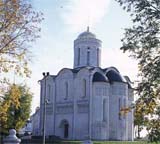
The Cathedral of St. Demetrius, built under the Prince Vsevolod III, is one of the most graceful and beautiful churches in Vladimir. It is like an icon in stone. It is the most mysterious church you will find in Vladimir; beauty and mystery are inseparably linked in it, which makes the Cathedral of St. Demetrius really special. The first mystery of the Cathedral is its birth, for no historical chronic mentions the time when this church was founded. However, many report that in 1197 the icon of St. Demetrius of Salonica was brought here from Byzantium. The next mystery is the Cathedral itself. Numerous relief images of lions, centaurs, snow leopards and exotic ornaments (more than 1000) are covered on its white-stone walls. The sculptural decor incorporates subjects from the Bible and classical Greek mythology. In the central parts of the facades the image of King David is repeated. In medieval times, he was associated with the celebration of beauty and harmony of the world. Though all these relief may seem now only mere decorations, a valuable garment, but they have had another function; of speaking to people, of inspiring them. What is concealed behind this symbolic form will hardly be open to anyone, but it is worth a try. If not the mystery, the beauty will surely penetrate you. Not all of the mysteries will be revealed because the interior of the Cathedral, where surviving fragments of 12th century frescoes and more are stored, is not open for visitors. more... |
The Golden gate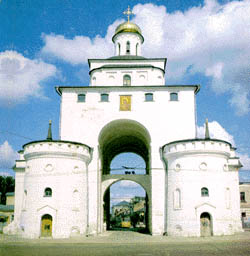
The Golden Gate erected in 1164 is one of the most outstanding symbols and was an indispensable part of the ancient city of Vladimir from the very beginning of its history. The Golden Gate was once a formidable fortress, a four-sided tower with great oak doors bound in gilded copper. Vladimir had several gates, but the Golden Gate was the main entrance to the city. Alexander Nevsky and Dmitri Donskoy passed through the Golden Gate to enter Vladimir and become princes of Ancient Russia. The Golden Gate saw glorious Russian troops march through it to deter threats, which Rus faced. The Golden Gate witnessed celebrations and tragedies, festives and destruction. Every time it rose from the ashes having survived the many disasters and catastrophes Vladimir has faced in its long history. Its greatest challenge was the attack by Mongol-Tartars. Today there are no Mongol-Tartars, and the Golden Gate stands strong and magnificent, reminding us of the great past the town of Vladimir had experienced. It is no longer located on the edge of the city and an entrance to the town. Instead it is the center of the large city and plays a role not of a military guard but of a peaceful observer, who is ready to share with us its successes and tragedies, falls and rises, ups and downs, stories and secrets. The Golden Gate now hosts a museum at its top, which invites everybody and promises an unforgettable visit. To visit a museum you will have to climb a step staircase. The Golden Gate is the most prominent symbol of Vladimir city, and it is unthinkable to consider Vladimir without them. more... |
Assumption cathedral
The magnificent Assumption Cathedral is what you see first when you enter Cathedral Square. It was different when it was built in 1158. Gilded decorative friezes, carved reliefs and multi-colored frescos graced its outer walls. Everything was destroyed in the great fire in 1185. That fire changed the face of the Cathedral, but the Cathedral remained a wonderful masterpiece and still retained its beauty. It survived the next great fire when Mongol-Tatars trapped all the prince's family in the cathedral and set it on fire. Assumption Cathedral, apart from being a solemn witness to these tragic events, also enjoyed fame and attention. It had been the principal church where princes of ancient Russia were crowned. In those times Vladimir had been the capital of Russia. The Cathedral retained its privileges for a long time after Vladimir lost its power and influence to rulers of Moscow, who took the title of grand-prince. Coronation ceremonies in the Assumption Cathedral were truly remarkable and outstanding. Historical chronicles remark on the abundant use of gold in decoration of both exterior and interior of the cathedral. Also the Cathedral housed the celebrated, miraculous icon of the Virgin of Vladimir, which is widely venerated throughout Russian lands. Truly beautiful are the 15th century frescoes found inside the Cathedral: "The Last Judgment", "Non-evening Light", and "Abraham's Bosom". These frescoes are the works of Andrei Rublev, one of the most famous of early Russian artists. Splendid altar and iconostasis adorning the interior of the Cathedral are worth visiting. The Cathedral experienced some changes in the 19th century, with additions to the ancient corpus of the Cathedral. A classical style bell-town was constructed with a tall golden helmet on the site of an ancient bell-fry that had been destroyed by lightning. In 1862, the chapel of St. George was erected between the bell tower and the cathedral. Assumption Cathedral is today a functioning church. Apart from admiring the beauty of the Cathedral, you can take part in its services. Such an experience you will never forget. more... |

